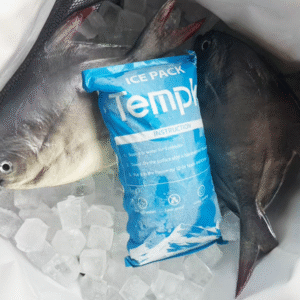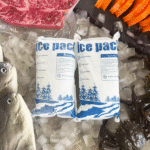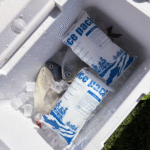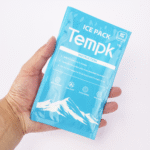Im sich schnell entwickelnden Kaltketten -Logistiksektor, Trockeneis ist seit langem der Standard für die Aufrechterhaltung der Temperaturen der Unter Null. Jedoch, mit zunehmenden Sicherheitsbedenken und Umweltauswirkungen, Die Branche verlagert sich in Richtung Trockeneis-Ersatzpackungen. Diese innovativen Lösungen sorgen für mehr Sicherheit, grüner, und kosteneffizientere Kühlmethoden, bietet eine praktikable Alternative für den Transport verderblicher Waren. In diesem Artikel, Wir werden uns damit befassen, warum Trockeneis-Ersatzverpackungen die Zukunft der Kühlkettenlogistik sind.

Was sind Trockeneis-Ersatzpakete und wie funktionieren sie??
Trockeneis-Ersatzpackungen sind innovative Kühlmittel, die herkömmliches Trockeneis in der Kühlkettenindustrie ersetzen sollen. Diese Packungen verwenden Materialien wie superabsorbierende Polymere (SAFT) oder Phasenwechselmaterialien (PCMs) zur Aufnahme und Abgabe von Wärme durch Phasenwechsel oder gelbasierte Systeme, Bietet zuverlässige Kühlung ohne die Sicherheitsrisiken von Trockeneis.
Im Gegensatz zu Trockeneis, welches zu Kohlendioxidgas sublimiert, Trockeneis-Ersatzpackungen bleiben stabil und sind sicher in der Handhabung. Sie wirken, indem sie Wasser absorbieren, zu einer gelartigen Substanz gefriert, und die Kälte während des Transports langsam abgeben, sorgt für eine konstante Temperatur.
Hauptvorteile von Trockeneis-Ersatzpaketen:
-
Sicherere Handhabung: Diese Packungen geben keine schädlichen Gase ab und verringern das Risiko von Erfrierungen.
-
Umweltfreundlich: Aus ungiftigen Materialien hergestellt, Sie bieten eine umweltfreundlichere Lösung für Trockeneis.
-
Kostengünstig: Mit wiederverwendbaren Optionen, Diese Pakete tragen dazu bei, die Kosten auf lange Sicht zu senken.
Wie unterscheiden sich Trockeneis-Ersatzpackungen von herkömmlichem Trockeneis??
Trockeneis ist die Lösung der Wahl für die Kühlkettenlogistik, aber es birgt Risiken, einschließlich möglicher Erfrierungen, Erstickung durch CO₂-Ansammlung, und Umweltbedenken. So stapeln sich Trockeneis-Ersatzpackungen:
| Besonderheit | Trockeneis | Trockeneis -Ersatzpackungen |
|---|---|---|
| Temperaturbereich | -78.5°C | -20°C bis -40°C |
| Kühldauer | Kurze Lebensdauer (12–24 Std) | Lang anhaltende (bis zu 48 HRS) |
| Sicherheit | Hohes Risiko (Erfrierung, CO₂ Gas) | Geringes Risiko (ungiftig, keine Gase) |
| Umweltauswirkungen | Hoch (Co₂ -Emissionen) | Niedrig (umweltfreundliche Materialien) |
| Wiederverwendbarkeit | Einweg | Wiederverwendbar |
| Kosteneffizienz | Niedrig (Einmalgebrauch) | Hoch (wiederverwendbar, geringere Gesamtkosten) |
Warum sind Trockeneis-Ersatzpackungen sicherer??
Herkömmliches Trockeneis birgt mehrere erhebliche Sicherheitsrisiken. Es sublimiert zu CO₂-Gas, was Sauerstoff in engen Räumen verdrängen kann, Es besteht Erstickungsgefahr. Zusätzlich, Der Umgang mit Trockeneis kann ohne angemessene Sicherheitsmaßnahmen zu Erfrierungen oder schweren Verbrennungen führen.
Trockeneis-Ersatzpackungen beseitigen diese Risiken. Sie sind ungiftig, und da sie keine Gase freisetzen, Es ist keine spezielle Belüftungs- oder Sicherheitsschulung erforderlich. Das Risiko von Erfrierungen oder Verletzungen wird deutlich reduziert, Dadurch werden sie sowohl für Arbeitnehmer als auch für Verbraucher sicherer.
Sicherheitsvorteile:
-
Keine schädlichen Gasemissionen: Trockeneisbeutel geben kein CO₂-Gas ab.
-
Keine spezielle Ausrüstung: Für diese Verpackungen ist keine Handhabung gefährlicher Materialien erforderlich.
-
Sicheres Handling: Da es keine extremen Temperaturen gibt, besteht keine Gefahr von Verbrennungen oder Erfrierungen.
Wie vergleichen sich Trockeneis-Ersatzpakete mit anderen Kühlmethoden??
Zu den weiteren Kühlmethoden zählen Gelpacks, Eisbeutel, und flüssiger Stickstoff, Doch Trockeneis-Ersatzpackungen sind ihnen in vielen Bereichen oft überlegen.
| Kühlmethode | Temperaturregelung | Dauer | Sicherheit | Kosten |
|---|---|---|---|---|
| Trockeneis | Extrem kalt (-78.5°C) | Kurz | Gefährlich, erfordert eine besondere Handhabung | Niedrig (Einmalgebrauch) |
| Gelpackungen | Mäßige Erkältung (~0°C bis -20°C) | Medium | Sicher, wiederverwendbar, ungiftig | Mäßig |
| Flüssiger Stickstoff | Ultra-kalte (-196°C) | Sehr kurz | Gefährlich, erfordert eine besondere Handhabung | Hoch |
| Trockeneis -Ersatzpackungen | Mäßige Erkältung (~-20°C bis -40°C) | Lang anhaltende (12–48 Std) | Sicher, wiederverwendbar, ungiftig | Hoch (wiederverwendbar) |
Trockeneis-Ersatzpackungen bieten eine ausgewogene Lösung und sorgen für zuverlässige Kühlung, längere Dauer, und ein sicherer, umweltfreundlichere Alternative im Vergleich zu anderen Methoden.
Die wachsende Nachfrage nach Trockeneis-Ersatzverpackungen in der Kühlkettenlogistik
B. Branchen wie die Pharmaindustrie, Essen, und Biotechnologie erfordern höhere Sicherheits- und Nachhaltigkeitsstandards, Die Beliebtheit von Trockeneis-Ersatzpackungen nimmt weiter zu. Die Pharmaindustrie, insbesondere, benötigt eine präzise Temperaturkontrolle für Impfstoffe und Biologika. Trockeneis-Ersatzpackungen bieten eine effiziente Lösung, sicherere Lösung für den Transport dieser empfindlichen Produkte.
Branchen, die von Trockeneis-Ersatzpaketen profitieren:
-
Pharmazeutika: Impfungen, Blutprodukte, und andere temperaturempfindliche Arzneimittel erfordern eine konsequente Anwendung, geregelte Kühlung.
-
Essen & Getränk: Verderbliche Waren wie Tiefkühlkost, Fleisch, und Molkereiprodukte benötigen eine zuverlässige Kühlung, um die Qualität während des Transports aufrechtzuerhalten.
-
Biotechnologie: Biologische Proben und Laborforschungsmaterialien profitieren von einer stabilen Temperaturkontrolle, Gewährleistung ihrer Integrität während des Transports.
Trends und Innovationen bei Trockeneis-Alternativen für 2025
In 2025, Fortschritte in der Materialwissenschaft führen zu noch leistungsfähigeren Trockeneis-Ersatzpackungen. Hersteller konzentrieren sich auf die Verbesserung der Kühlleistung, Verbesserung der Materialien für längere Kühlzeiten, und Steigerung der Nachhaltigkeit.
Neueste Entwicklungen:
-
Verbesserte Materialien: Neue SAP-Formulierungen, die längere Kühlzeiten und eine bessere Wärmespeicherung bieten.
-
Intelligente Verpackungen: Integration einer IoT-Temperaturüberwachung zur Gewährleistung einer präzisen Kontrolle während des Transports.
-
Nachhaltige Lösungen: Biologisch abbaubare und recycelbare Außenfolien zur Reduzierung der Umweltbelastung.
Häufig gestellte Fragen zu Trockeneis-Ersatzpaketen
Q1: Sind Trockeneis-Ersatzpackungen wiederverwendbar??
Ja, Trockeneis-Ersatzpackungen sind für die mehrfache Wiederverwendung konzipiert, Dies macht sie zu einer kostengünstigen und umweltfreundlichen Option für die Kühlkettenlogistik.
Q2: Wie wähle ich das richtige Trockeneis-Ersatzpaket für meine Sendung aus??
Wählen Sie das passende Paket anhand von Faktoren wie dem erforderlichen Temperaturbereich aus, Transitdauer, und die Art der versendeten Waren. Die Recherche zu Phasenwechselmaterialien und Spezifikationen wird Ihnen bei Ihrer Entscheidung helfen.
Q3: Sind Trockeneis-Ersatzpackungen teurer als Trockeneis??
Während Trockeneis-Ersatzpackungen möglicherweise höhere Anschaffungskosten haben, Ihre Wiederverwendbarkeit und Umweltvorteile machen sie mit der Zeit kosteneffizienter, vor allem für den häufigen Gebrauch.
Abschluss: Die Zukunft der Kühlkettenlogistik mit Trockeneis-Ersatzverpackungen
Trockeneis-Ersatzpackungen bieten eine sicherere Lösung, nachhaltiger, und kostengünstige Alternative zu herkömmlichem Trockeneis in der Kühlkettenlogistik. Da die Industrie weiterhin der ökologischen Nachhaltigkeit Priorität einräumt, Sicherheit, und Kosteneffizienz, Die Akzeptanz dieser Pakete wird voraussichtlich zunehmen 2025 und darüber hinaus.
Umsetzbare Erkenntnisse:
-
Wechseln Sie zu Trockeneis-Ersatzpackungen: Der Umstieg von Trockeneis kann die Sicherheit verbessern und die Umweltbelastung verringern.
-
Bewerten Sie Ihre Kühlkettenanforderungen: Wählen Sie die richtige Verpackung basierend auf den Temperaturanforderungen Ihrer Produkte.
-
Bleiben Sie mit neuen Technologien auf dem Laufenden: Integrieren Sie Innovationen bei Kühlmaterialien und Überwachungssystemen, um Ihre Logistik weiter zu optimieren.
Über Tempk
Tempk ist ein führender Anbieter von temperaturgesteuerten Lösungen, Wir bieten leistungsstarke Trockeneis-Ersatzverpackungen an, die speziell auf die Kühlkettenlogistikbranche zugeschnitten sind. Mit einem Bekenntnis zur Sicherheit, Nachhaltigkeit, und Innovation, Die Produkte von Tempk sorgen für einen zuverlässigen und umweltfreundlichen Transport temperaturempfindlicher Güter.
Entdecken Sie, wie Tempk Ihre Kühlkettenabläufe verbessern kann. Kontaktieren Sie uns noch heute für kompetente Beratung und maßgeschneiderte Lösungen!






















